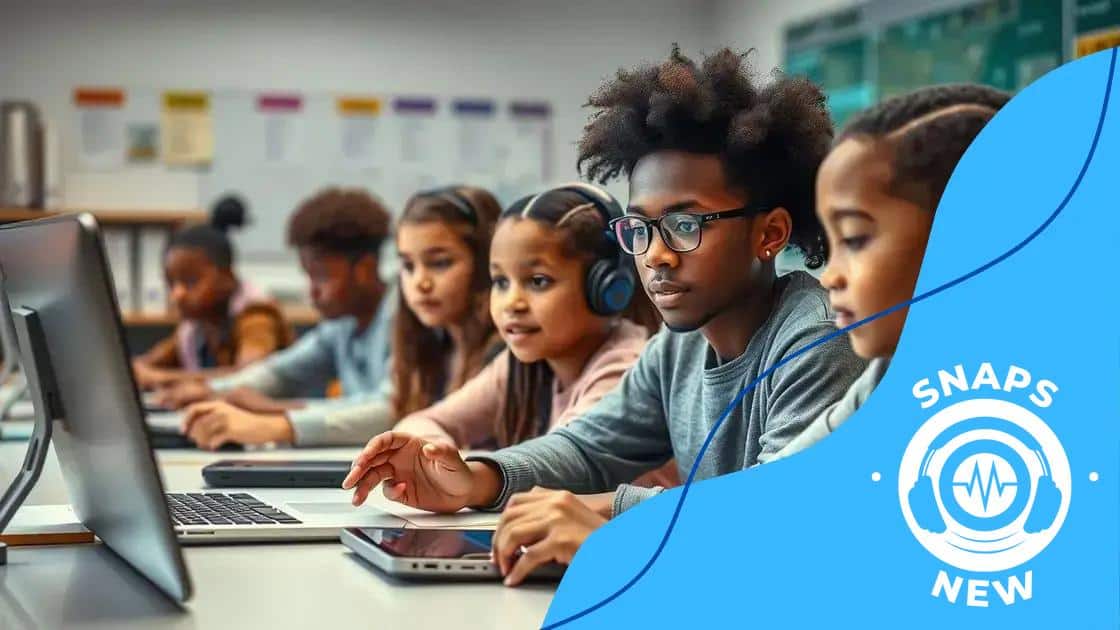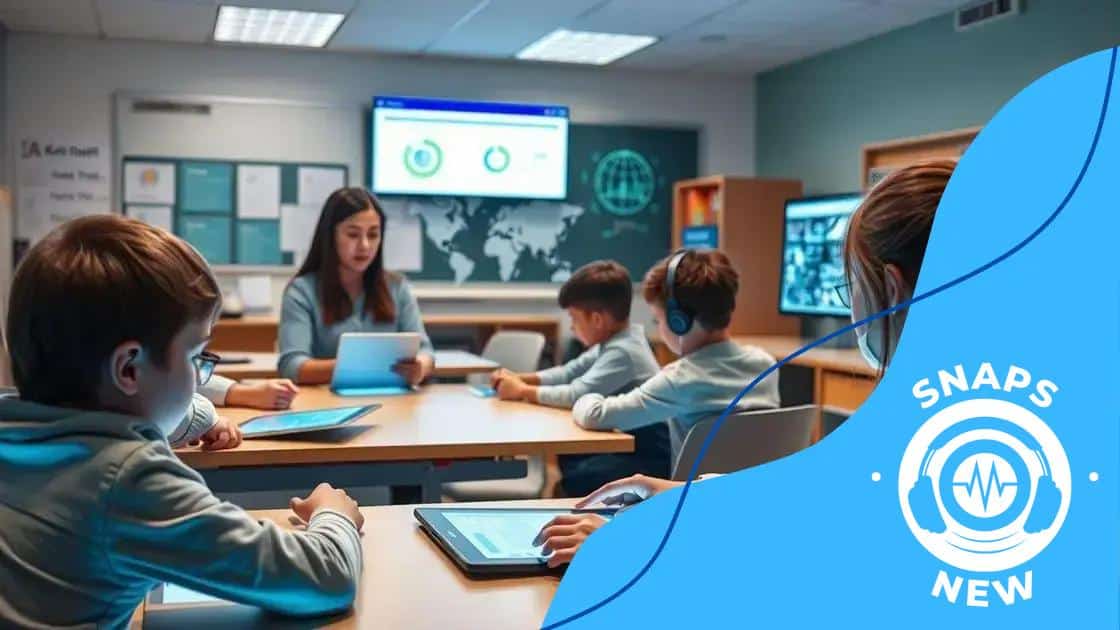AI in special education: unlocking new opportunities

AI in special education enhances learning by providing personalized experiences, improving communication for diverse learners, and supporting educators with data-driven insights and adaptive tools.
AI in special education is making waves, reshaping how educators approach diverse learning needs. Have you ever wondered how technology can personalize education for all students? Let’s dive into the various ways AI is creating inclusive classrooms.
The role of AI in personalized learning
In today’s educational landscape, AI in personalized learning plays a transformative role. It tailors educational experiences to meet the unique needs of each student. By adapting lessons to individual learning styles, AI helps students grasp concepts more effectively.
Benefits of AI in Personalized Learning
Integrating AI into the learning process offers numerous advantages. Here are some key benefits:
- Facilitates customized learning paths
- Provides real-time feedback and assessments
- Encourages student engagement
- Enhances teacher productivity
Another significant aspect of AI in personalized learning is its ability to analyze student data. This data helps educators understand strengths and weaknesses, enabling them to adjust their teaching methods accordingly. The more data AI processes, the more refined its recommendations become, creating an enriching educational experience.
How AI Adapts to Individual Needs
AI systems can identify when a student struggles with a particular topic. For instance, if a student is having difficulty in math, the AI can provide extra exercises tailored to that specific area. This individualized approach not only boosts confidence but also improves the overall understanding of subjects.
Likewise, AI in personalized learning can create an inclusive environment. It accommodates diverse learners, including those with special needs, by offering tailored resources that suit various learning paces. This adaptability ensures every student, regardless of background, can thrive in the classroom.
Incorporating AI doesn’t mean replacing teachers; rather, it acts as a powerful tool that supports educators in delivering effective instruction. By automating repetitive tasks, teachers can focus more on fostering relationships and enhancing critical thinking skills among students.
Overall, embracing AI in personalized learning paves the way for a future where education is not one-size-fits-all but a dynamic and engaging experience for each learner.
Enhancing communication for students with disabilities
Enhancing communication for students with disabilities is crucial in creating an inclusive educational environment. By utilizing technology and innovative strategies, educators can support students in expressing themselves effectively.
Role of Assistive Technology
Assistive technology plays a vital role in improving communication. These tools can include devices and applications that help students articulate their thoughts and needs. Here are some examples:
- Speech-generating devices
- Text-to-speech applications
- Augmentative and alternative communication (AAC) systems
- Communication boards or apps
Each of these tools empowers students with disabilities, allowing them to share ideas and participate more fully in classroom discussions. The integration of such technology ensures that every voice is heard.
Personalized Communication Strategies
Personalized communication strategies also enhance interactions among peers. Understanding each student’s unique way of communicating allows teachers to tailor their approaches. For example, some students may thrive with visual support, while others benefit from hands-on activities. The goal is to create a comfortable space where students feel encouraged to engage.
Furthermore, fostering collaboration between students can promote understanding and friendship. When students learn to communicate with each other, they build social skills that are necessary in everyday life. Group activities that involve sharing stories or ideas can strengthen these connections.
Creating an inclusive atmosphere is critical, and teachers play an integral role. By actively listening and adjusting their communication methods, educators can bridge the gap between students with disabilities and their peers. This dynamic interaction helps cultivate empathy within the classroom.
Support from families also enhances communication efforts. Involving parents in discussions about their children’s needs can provide valuable insights. This collaborative approach leads to better strategies that resonate with each student.
AI tools for assessment and progress tracking

AI tools for assessment and progress tracking are revolutionizing how educators monitor student growth. These tools enable teachers to gather valuable data about student performance in real time, making it easier to identify strengths and areas for improvement.
Types of AI Assessment Tools
Various AI solutions assist in creating personalized assessments. Here are some effective tools:
- Adaptive testing platforms that adjust difficulty based on student responses
- Automated grading systems that provide instant feedback
- Learning analytics dashboards that track student performance over time
- Online quizzes and assessments that offer a wide range of question types
These tools not only improve assessment efficiency but also provide insights into learning habits. They help educators understand how students interact with content and where additional support may be needed.
Real-Time Feedback and Adjustments
One of the significant advantages of AI in assessments is the ability to give real-time feedback to students. This immediate response helps learners understand their mistakes and correct them promptly. Moreover, teachers can adjust their teaching strategies based on this feedback.
Through continuous tracking, AI tools make it easier for educators to analyze patterns in student performance. For example, if several students struggle with a particular concept, a teacher can revisit that lesson and explore new teaching methods. This adaptability ensures all learners receive the support they need.
AI improves not just the academic monitoring process but also enhances communication between teachers and students. When students see their progress and understand their learning journey, they are more motivated to engage in their education. The transparency provided by these tools has a significant positive impact on student morale.
To maximize the benefits of AI for assessment, schools need to invest in proper training for teachers. Understanding how to interpret the data from AI tools is crucial for implementing actionable strategies that benefit students. By embracing these technologies, educators can create a dynamic learning environment that meets the needs of every student.
Case studies: AI success stories in special education
Case studies reveal how AI is making a difference in special education. These real-world examples highlight the success stories of students and educators using innovative technologies to enhance learning experiences.
Student-Centered Approaches
One notable case study involves a school that implemented AI-driven learning tools tailored to students with varying disabilities. By using personalized learning platforms, the students could work at their own pace, enabling them to master concepts more effectively. As a result, many students demonstrated significant improvements in their academic performance.
- Increased engagement in lessons
- Higher test scores compared to previous years
- Enhanced confidence in learning
These outcomes underline how AI not only benefits academic progress but also nurtures emotional and social growth in students.
Data-Driven Insights
Another successful implementation showcased how teachers utilized AI to collect data on student progress. The insights garnered from AI analytics allowed educators to identify patterns and tailor their teaching methods accordingly. For instance, if data showed that a particular group struggled with comprehension, teachers could modify their instruction to better suit those needs.
Such adjustments led to increased collaboration amongst students, allowing them to support one another in grasping challenging concepts. The impact of this approach is substantial, as it fosters a community of learners who can thrive together.
In a separate instance, a school district adopted AI-powered tools that facilitated communication for non-verbal students. The introduction of these assistive technologies allowed these students to express their thoughts and feelings, leading to greater participation in classroom discussions.
Long-Term Benefits
Over time, these case studies demonstrate the long-term benefits of incorporating AI in special education. Students not only enhance their academic skills but also develop essential social skills that will benefit them beyond the classroom. The stories of success encourage other schools to explore how AI can be a valuable resource in providing inclusive educational opportunities.
As we learn from these examples, it becomes evident that integrating AI in special education not only meets the diverse needs of students but also opens doors for potential that was previously untapped.
Challenges and considerations in implementing AI
Implementing AI in special education comes with several challenges and considerations. While the benefits are substantial, understanding the obstacles can help educators and administrators strategize for effective integration.
Understanding Technological Barriers
One major challenge is the technological barrier. Many schools may lack the resources necessary for implementing advanced AI systems. Accessing reliable internet and modern devices is crucial for AI tools to function correctly.
- Insufficient hardware and software can limit AI effectiveness.
- Technical training for teachers is often needed to make full use of AI capabilities.
- Budget constraints can prevent schools from acquiring necessary technology.
These barriers can hinder the adoption of AI, making it essential for schools to plan for necessary investments and resources to use AI effectively.
Data Privacy and Security Concerns
Another significant consideration involves data privacy and security. AI tools often require access to student data, which raises questions about how that data is collected and protected. Ensuring compliance with regulations like FERPA is vital.
Schools must prioritize safeguarding sensitive information to maintain trust among students and parents. This includes implementing strong cybersecurity measures and transparent data usage policies.
Moreover, educators need to communicate clearly with stakeholders about how AI will enhance learning while respecting individual privacy. This communication is vital for fostering a positive view of AI integration.
Balancing AI with Human Interaction
While embracing technology, it’s crucial to maintain a balance between AI and human interaction. AI tools should support teachers, not replace them. Teachers bring empathy and understanding that AI cannot fully replicate.
Training educators to combine AI insights with personal teaching methods is essential. By creating a hybrid approach, schools can provide an enriched learning experience that leverages technology while fostering meaningful connections.
In addition, educators should be mindful of the potential for over-reliance on technology. Maintaining a focus on holistic education that addresses social and emotional needs alongside academic growth is important.
In conclusion, the integration of AI in special education offers tremendous potential to enhance learning experiences for students with diverse needs. Although there are challenges to consider, such as technological barriers and data privacy, the benefits are significant. By utilizing AI tools thoughtfully, educators can provide personalized learning opportunities, improve communication, and encourage collaboration among students. It’s crucial to balance technology with human interaction, ensuring that the emotional and social aspects of education remain at the forefront. With the right strategies, the future of special education can be brighter and more inclusive for all students.
FAQ – Frequently Asked Questions about AI in Special Education
How can AI enhance learning for students with disabilities?
AI provides personalized learning experiences, adapts to individual needs, and helps track progress, making education more effective.
What challenges come with implementing AI in schools?
Challenges include technological barriers, data privacy concerns, and ensuring a balance between AI tools and human interaction.
What types of AI tools are available for educators?
There are various tools like adaptive learning platforms, speech-generating devices, and analytics dashboards that support different aspects of learning.
How does AI promote inclusivity in education?
AI helps create customized learning paths, supports communication for non-verbal students, and enables tailored resources for diverse learners.





